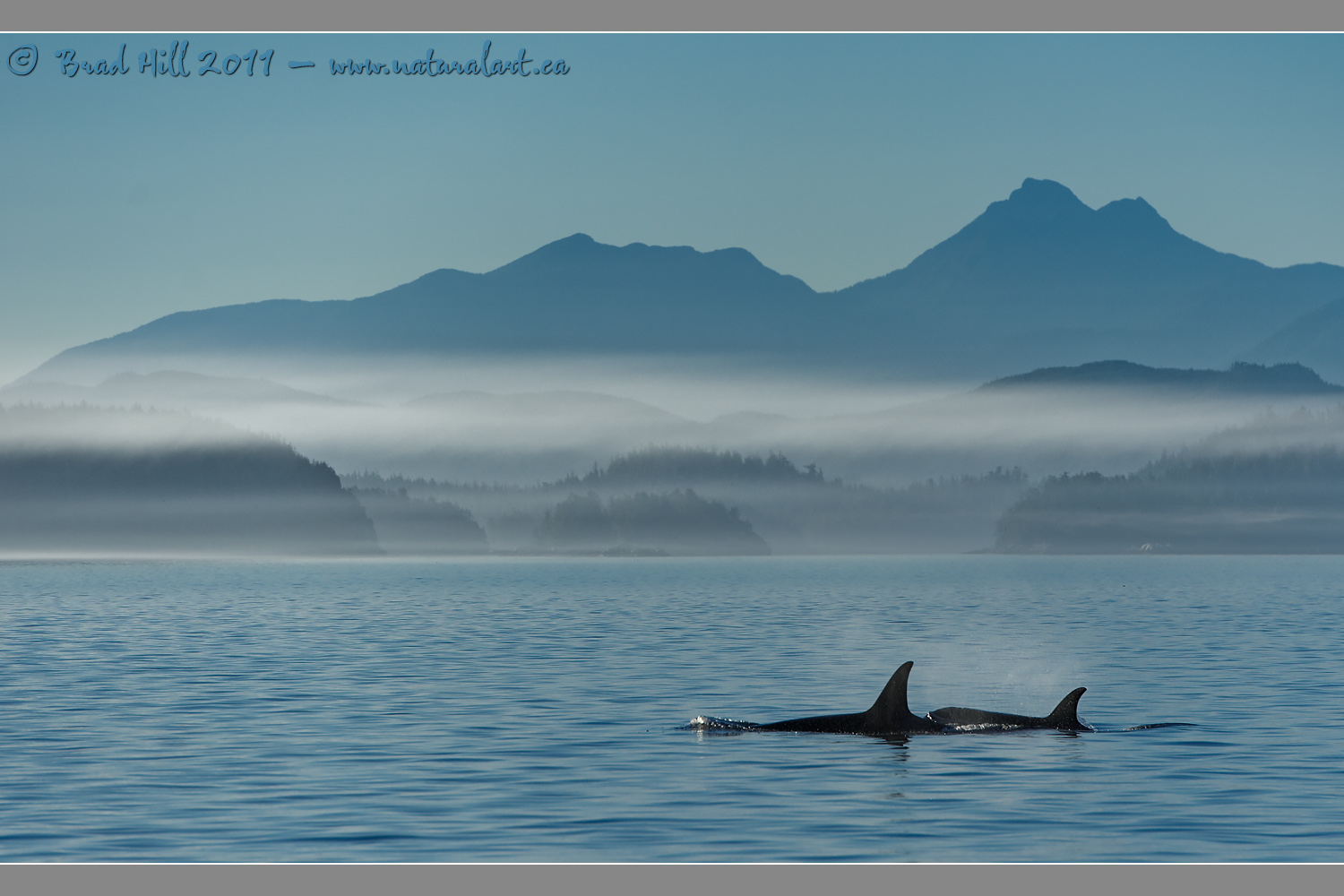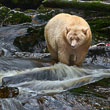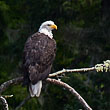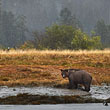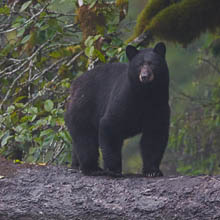Availability: Limited Edition Print - info coming soon!
In the Field
Orca Heaven? Northern Vancouver Island, BC, Canada. August 25, 2010.
I have no idea what an Orca would consider heaven to be like (or if the thought has ever crossed their complex brains), but I'm guessing that it wouldn't involve much consideration of dramatic or picturesque backdrops like the one these two are swimming in front of. So why use the title "Orca Heaven" for this image? Well, as it turns out, these Orcas - which are members of a resident pod found near the northern end of Vancouver Island and, as such, are fish-eaters - are swimming through these waters just when the largest sockeye salmon run in close to 100 years was passing through! Estimated at between 32 and 35 million fish, it's hard to imagine that this run didn't at least please or - less anthropomorphically - reduce the hunger stress on these amazing mammals!
Talk to almost any experienced pro (or serious amateur) photographer and you'll hear them say that on any important "shoot" you should always bring at least two camera bodies along. This is especially true if you're shooting in a region that's remote (or, equally important, expensive to get to). The first reason for this is common sensical - if one camera fails you have a backup to use. In wildlife photography there's often another reason that's related to the non-uniform distribution of your subjects in time and space. Huh? Well, by this I mean that wildlife photography is often characterized by long periods of waiting when nothing is happening (no subjects around or, if they are, they may be doing nothing that's interesting photographically, like sleeping in long grass). During this time BOTH cameras are sitting there doing nothing. But...things can start happening awfully fast when the subjects show up (or, using my other example, wake up).
In the case shown here, we had been waiting for a good hour with nothing happening around us when suddenly Orcas starting showing up all around our boat. They were surfacing at various distances away from the boat and, depending on where they surfaced, in spots where the backgrounds were far in the distance (as in 25 or more kilometers) or quite close (a kilometer or two). On top of that, you often only had a few seconds (and certainly less than a minute) to catch the whales surfacing in the right place to create a pleasing image. JUST prior to shooting this image I had been working with a pair of whales with a mountain range far in the distance and had been using a super-telephoto to "compress" the distance between the subjects and the background and to increase the size of the background. Then I heard these two "blowing" nearby and when I turned I had the scene above unfold (very, very fast) in front of me. Fortunately, I had a second camera body with a shorter zoom lens "on-hand" and I was able to capture this image.
So...how does one keep a second body and lens "on-hand" and both conveniently and quickly accessible? There are a plethora of solutions for taking cameras into the field. One popular option for nature photographers is a backpack-style camera bag. There are many makers and almost countless models of these available (most of which line the walls of my office!) and the majority of them are good for carrying photographic gear into the field. BUT, in most cases, once you get to your destination they are taken off and placed on the ground. And, in many cases, whether the pack is on your back or on the ground, accessing the gear really fast isn't possible. In the last year or so I have taken to using a "belt and shoulder strap plus holster" system that allows me to wear some of my gear while in the field. I tend to use it in situations where I have one camera with a long lens (400mm to 600mm) in use (usually on a tripod) but I'm in a situation where subjects MAY emerge or move close enough to me to make the big lenses useless. I normally end up "wearing" a pro body with a 70-200mm lens mounted to it in my holster system. I've been using Think Tank Photo's belt system (go here for information about it, including pricing info) and it's been working well for me. Without it, odds are I would never have captured this shot (or many, many of the "spontaneous" bear photos I've captured recently).
Here's a higher resolution (2400 pixel) version of this tranquil scene:
• Orca Heaven? Download 2400 pixel image (JPEG: 0.95 MB)
ADDITIONAL NOTES:
1. This image - in all resolutions - is protected by copyright. I'm fine with personal uses of it (including use as desktop backgrounds or screensavers on your own computer), but unauthorized commercial use of the image is prohibited by law. Thanks in advance for respecting my copyright!
2. Like all wildlife photographs on this website, this image was captured following the strict ethical guidelines described in The Wildlife FIRST! Principles of Photographer Conduct. I encourage all wildlife photographers to always put the welfare of their subjects above the value of their photographs.
3. This image was captured during my "Humpback, Orcas, Sea Lions & More" photo tour in August of 2010. Each year I offer trips into two different parts of the Great Bear Rainforest as well as one to photograph aquatic mammals and oceanscapes near the northern tip of Vancouver Island. And, in selected years, I also offer photo tours to locations to capture other highly sought-after subjects, such as various owl species of the boreal forest and wildlife of Canada's Arctic. Details about these trips can be found on the Photo Tours page of this website.
Behind the Camera
Orca Heaven? Northern Vancouver Island, BC, Canada. August 25, 2010.
Digital Capture; RAW 14-bit format; ISO 200.
Nikon D700 with Nikkor 70-200mm f2.8 VRII lens (@ 200mm) hand-held and shot from sailboat. VR on and set to "Normal" mode. Circular polarizer used.
1/2000s @ f5; -033 stop compensation from matrix-metered exposure setting.
At the Computer
Orca Heaven? Northern Vancouver Island, BC, Canada. August 25, 2010.
RAW Conversion to 16-bit TIFF, including first-pass/capture sharpening using Phase One's Capture One Pro 5.
Further digital corrections on 16-bit TIFF file using Adobe's Photoshop CS5 and Light Craft's LightZone. Photoshop adjustments included selective contrast adjustment (via curves adjustment) to zone including foggy mid-ground islands and selective saturation adjustment. Final tonemapping and contrast/tone tweaking performed with LightZone using the tonemapper/re-light tool.
Conservation
Orca Heaven? Northern Vancouver Island, BC, Canada. August 25, 2010.
Ten percent of the revenue generated by this image will be donated to Raincoast.
Species Status in Canada*: Endangered - Northeast Pacific southern resident population; Threatened - Northeast Pacific transient population and the Northeast Pacific northern resident population; Special Concern - Northeast Pacific offshore population.
Killer Whales (Orcinus orca) have an extremely high profile in modern pop culture and have become the "poster child" of a number of conservation groups. In most areas where Killer Whales are found they show a remarkable ability to adapt to a variety of habitats - they are found in all oceans, in water ranging in temperature from below 0 Celsius to almost hot tropical waters, and will occasionally even spend significant amounts of time in brackish water or even rivers.
Because the population sizes of Killer Whales are very low and because they have a very low reproductive rate, they face immediate risk from human-related environmental disturbances, including the immunotoxic effects of toxic chemicals we pour into the oceans and to reduction in prey availability (such as salmon).
These two Killer Whales were photographed along the coast in British Columbia's Great Bear Rainforest. The Raincoast Conservation Society is fighting to protect the Great Bear Rainforest along the central and northern coast of British Columbia. This unique ecosystem harbours a strong population of many high-profile species such as Brown Bears and Gray wolves, plus many species that serve as prey for the Killer Whale. If you are looking for a meaningful way to contribute to the conservation of the Great Bear Rainforest and all its associated species, Raincoast will provide maximal "bang" for your conservation dollars.
For more information on the status of Killer Whales in Canada, go to: http://www.speciesatrisk.gc.ca and search under "Killer Whale".
*as determined by COSEWIC: The Committee on the Status of Endangered Wildlife in Canada













